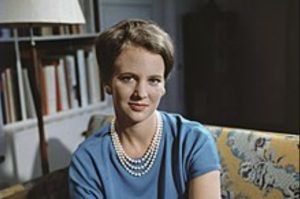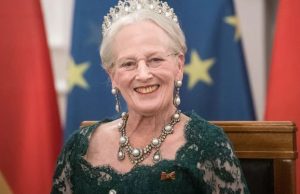How did a young princess born into Danish royalty become one of the most respected monarchs in Europe? Queen Margrethe II of Denmark has led her nation through decades of change while upholding the traditions of the Danish monarchy.
From her early years as Princess Margrethe to her historic ascension as Denmark’s first reigning queen in centuries, her journey is a captivating story of duty, education, and cultural influence. In this blog, we explore the life and reign of Queen Margrethe, who has shaped modern Denmark with grace, intellect, and unwavering dedication.
Who is Denmark Queen Margrethe?

Image – Source
Queen Margrethe II of Denmark is the longest-reigning current monarch in Europe. She became the first female monarch of Denmark in centuries, succeeding her father, King Frederik IX, after his passing in 1972. As a constitutional monarch, her role is largely ceremonial, yet she remains a central figure in Danish public life. Her reign has spanned over 50 years, during which she has guided Denmark through significant societal and cultural changes, modernizing the monarchy while maintaining its historical traditions.
On the international stage, Queen Margrethe is recognized for her diplomatic efforts and her deep interest in the arts and culture. Fluent in several languages and educated at some of the world’s leading institutions, she has gained respect not only in Denmark but across Europe and beyond. Her influence reaches far beyond political matters, as she continues to engage in various artistic and literary projects, cementing her place as a cultural icon.
Early Life and Royal Heritage
Princess Margrethe Alexandrine Þórhildur Ingrid was born on April 16, 1940, into the House of Glücksburg, Denmark’s royal family. She is the eldest daughter of King Frederik IX and Queen Ingrid, and her birth took place during a turbulent period in Europe, amidst the early days of World War II. Margrethe’s lineage is intertwined with European royalty; her maternal grandfather was King Gustaf VI Adolf of Sweden, further highlighting her royal roots.
Raised in a family steeped in Danish traditions, her father, King Frederik IX, played a crucial role in shaping her understanding of monarchy and her future responsibilities. Margrethe’s upbringing combined royal traditions with a relatively informal family life, preparing her for the delicate balance between being approachable and upholding the dignity of the Danish crown.
Education and Preparation for the Throne
Queen Margrethe’s education reflects the importance placed on academic excellence and cultural understanding. She studied in Denmark and abroad, attending schools and universities that gave her a broad intellectual foundation. Some of the institutions she attended include Girton College, Cambridge, Aarhus University, and the London School of Economics.
Her studies spanned various fields such as political science, archaeology, and economics. This education was critical in preparing her for the challenges of modernizing a monarchy. It also allowed her to build relationships with other world leaders, a skill that would prove useful in her later diplomatic engagements.
Beyond formal education, Margrethe was groomed for leadership through her cultural training. Danish history, political systems, and her family’s long-standing role in public life were integral aspects of her preparation.
From Princess to Heir Apparent
The path to becoming Queen was not initially clear for Margrethe. At the time of her birth, Denmark’s succession laws followed a male-preference primogeniture, meaning women could not ascend the throne. However, with no male heirs in her immediate family and changing societal views, the Act of Succession was amended in 1953, making Margrethe the heir apparent. This was a pivotal moment in Danish history, as it allowed for the first female monarch in centuries.
As Crown Princess, Margrethe took on numerous responsibilities, including official duties and public appearances alongside her father. This period helped her gain valuable experience and prepare for the responsibilities of monarchy.
Becoming Queen Margrethe II

Image – Source
In January 1972, King Frederik IX passed away after a long illness, marking the end of an era. Upon his death, Margrethe ascended the throne, becoming Queen Margrethe II of Denmark. Her coronation was a significant event in Denmark’s modern history, as she became the first woman to rule Denmark since Queen Margrethe I in the 15th century.
Margrethe’s ascension was seen as a new chapter for Denmark, a moment where tradition met modernity. Her reign symbolized continuity with the past while also signaling a future where women could hold the highest office in the country.
The Reign of Queen Margrethe II
Throughout her reign, Queen Margrethe II has maintained her role as a constitutional monarch, a position that requires neutrality in political matters. While her duties are largely ceremonial, her influence extends beyond simple pageantry. She has played a key role in representing Denmark on the world stage and is often involved in cultural and charitable initiatives.
One of her significant achievements is her ability to adapt to societal changes. Over the years, Denmark has transformed into a progressive, modern society, and Queen Margrethe has been a steadying force during this transition. Her openness to modernization, particularly within the royal family, has earned her respect both at home and abroad.
Culturally, Queen Margrethe has made her mark through her involvement in the arts. She has designed sets for the Royal Danish Ballet, illustrated books, and contributed to a variety of artistic projects, further establishing her legacy as a monarch with a deep appreciation for the creative world.
Personal Life and Public Image
In 1967, Margrethe married Henri de Laborde de Monpezat, a French diplomat who later became known as Prince Henrik of Denmark. Their marriage was one of partnership and support, with Prince Henrik playing an active role in her reign. Together, they had two sons, Crown Prince Frederik and Prince Joachim, ensuring the future of the Danish royal family.
Margrethe’s public image has been shaped by her humility, approachability, and dedication to her people. While she upholds the traditions of the monarchy, she has also shown herself to be a relatable and warm figure, balancing the demands of her role with a personal touch.
Challenges and Modernization of the Danish Monarchy
One of the main challenges Queen Margrethe has faced is maintaining the relevance of the monarchy in a rapidly changing world. She has navigated this by embracing modernization while respecting royal traditions. Her transparency about her role, and her visible presence in Danish society, have helped keep the monarchy in step with contemporary values.
Health has been a challenge for the queen in recent years. She underwent surgery for her back and has dealt with other health issues. Despite this, Queen Margrethe remains active in her duties, underscoring her commitment to the Danish people.
Queen Margrethe’s Legacy and Future of the Danish Monarchy

Image – Source
As Denmark’s longest-reigning monarch, Queen Margrethe II’s legacy is one of stability, modernization, and cultural contribution. Her ability to adapt to the evolving political landscape while preserving Denmark’s royal traditions has made her a beloved figure.
Looking to the future, her son, Crown Prince Frederik, is expected to succeed her, ensuring that the Danish monarchy continues to play a significant role in the nation’s identity. Queen Margrethe’s influence on both her country and her family is undeniable, and her legacy will be felt for generations to come.
Conclusion
Queen Margrethe II’s life and reign symbolize the delicate balance between tradition and modernization. As Denmark’s first female monarch in centuries, she has led the country through pivotal changes while remaining a steady and beloved figure in Danish society.
Her contributions to culture, her diplomatic efforts, and her personal resilience continue to leave a lasting mark on Denmark and the world. As her reign progresses, Queen Margrethe’s legacy will be remembered as one of dignity, cultural richness, and profound influence on both her nation and her family.
FAQs About Queen Margrethe II
How did Queen Margrethe become the first female monarch in centuries?
She became the heir apparent after Denmark’s Act of Succession was changed in 1953 to allow female succession.
What was the significance of her father, King Frederik IX, in her life?
King Frederik IX played a major role in shaping her understanding of monarchy and public service, which prepared her for her future role as queen.
What challenges did Queen Margrethe face during her reign?
Her main challenges included modernizing the monarchy and navigating personal health issues while maintaining her responsibilities.
How has Queen Margrethe influenced Danish culture?
Through her involvement in the arts and her own creative projects, she has significantly contributed to Denmark’s cultural landscape.
Who will succeed Queen Margrethe?
Her eldest son, Crown Prince Frederik, is next in line to the throne.
What health challenges has Queen Margrethe faced in recent years?
She has faced back issues that required surgery and other age-related health challenges.
What is Queen Margrethe’s legacy in the history of Denmark?
Her legacy includes being a modernizing force in Danish royalty, her cultural contributions, and her long, stable reign.
Featured Image – Source
Disclaimer
The images used in this blog are not owned by the Couples Blog; the copyrights of these images belong solely to their respective owners.






